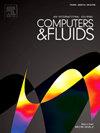采用尖锐界面技术对液滴层体系中的完全和部分电凝聚进行多相中模拟的数值分析
IF 2.5
3区 工程技术
Q3 COMPUTER SCIENCE, INTERDISCIPLINARY APPLICATIONS
引用次数: 0
摘要
本文对悬浮在油中的水滴在恒定电场影响下与水层的凝聚进行了数值研究。与大多数现有研究不同,计算基于任意拉格朗日-欧勒方法(ALEM)的应用,该方法也称为移动网格法,属于具有尖锐界面的两相液体建模方法。使用这种方法可以避免表面电荷从界面 "逃逸 "的错误现象,这种现象在使用涉及扩散界面的方法时经常出现。尽管 ALEM 默认情况下不允许描述拓扑结构的变化,但我们还是建立了一个数值模型,将计算分为三个部分:在接触瞬间之前液滴和液层的汇聚;在接触瞬间手动构建桥梁;液滴和液层的结合。根据所建立的模型,我们可以得出这一过程的三种可能模式:完全聚合、部分聚合和一种尚未实际考虑过的拉伸模式。分离的次级液滴的体积与初始液滴的大小和外加电场的平均强度有关。该模型与实验研究显示出良好的定量一致性。研究表明,在部分凝聚的情况下,形成桥和颈的点一般并不重合。获得了凝聚模式图,即在初始液滴半径和电场强度的广泛范围内,从凝聚到部分凝聚以及从部分凝聚到拉伸机制的过渡阈值的相关性。结果表明,存在一个最大电场强度,在该强度下,任何大小的液滴都会与层合并。该图使得预测电凝聚器中的凝聚机制成为可能。所提出的建模技术可用于计算不同主要参数值下的电凝聚模式,这将有助于在设计阶段优化电凝聚器。本文章由计算机程序翻译,如有差异,请以英文原文为准。
The numerical analysis of complete and partial electrocoalescence in the droplet-layer system employing the sharp interface technique for multiphase-medium simulation
In this paper, the coalescence of a drop of water suspended in oil with a layer of water under the influence of a constant electric field is numerically investigated. Unlike most existing studies, the calculations are based on the application of the arbitrary Lagrangian-Eulerian method (ALEM), also called the moving mesh method, which belongs to the class of methods for modeling two-phase liquids with a sharp interface. Using this approach made it possible to avoid a false "escape" of the surface charge from the interface, which often occurs when using methods involving a diffuse interface. Despite the fact that ALEM does not allow describing topology changes by default, a numerical model was implemented in which the calculation is divided into three parts: the convergence of the drop and the layer before the moment of touch; the manual construction of the bridge at the moment of touch; the union of the drop and the layer. The developed model allowed us to obtain three possible modes of this process: complete coalescence, partial coalescence and a mode of stretching which has not practically been considered yet. The dependence of the volume of the separated secondary droplet on the size of the initial droplet and the average intensity of the applied electric field is obtained. The model showed good quantitative agreement with experimental studies. It has been shown that generally, the spots where the bridge and the neck are formed in case of partial coalescence do not coincide. A map of coalescence modes was obtained, i.e., the dependence of the transition threshold from coalescence to partial coalescence and from partial coalescence to stretching regime in a wide range of radii of initial droplets and electric field strengths. It has been shown that there is a maximum field strength at which droplets of any size merge with the layer. This map makes it possible to predict the coalescence regime in electrocoalescer. The proposed modeling technique can be used to calculate electrocoalescence modes at various values of the main parameters, which will help to optimize electrocoalescers at the design stage.
求助全文
通过发布文献求助,成功后即可免费获取论文全文。
去求助
来源期刊

Computers & Fluids
物理-计算机:跨学科应用
CiteScore
5.30
自引率
7.10%
发文量
242
审稿时长
10.8 months
期刊介绍:
Computers & Fluids is multidisciplinary. The term ''fluid'' is interpreted in the broadest sense. Hydro- and aerodynamics, high-speed and physical gas dynamics, turbulence and flow stability, multiphase flow, rheology, tribology and fluid-structure interaction are all of interest, provided that computer technique plays a significant role in the associated studies or design methodology.
 求助内容:
求助内容: 应助结果提醒方式:
应助结果提醒方式:


